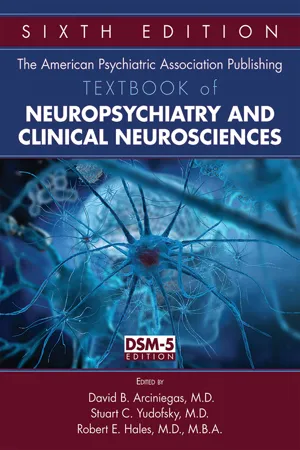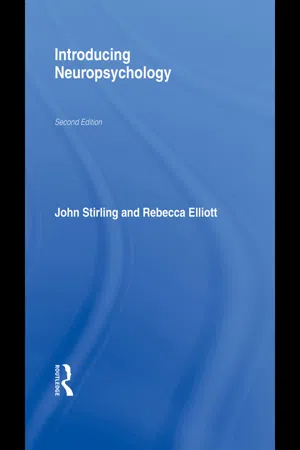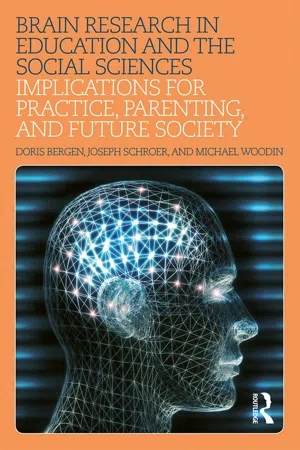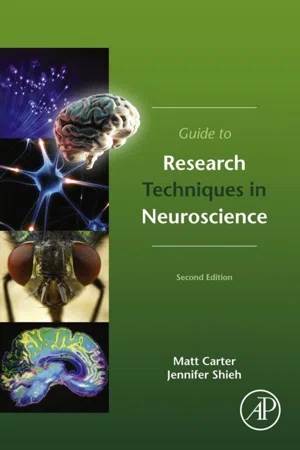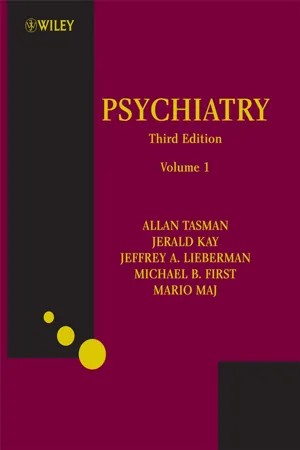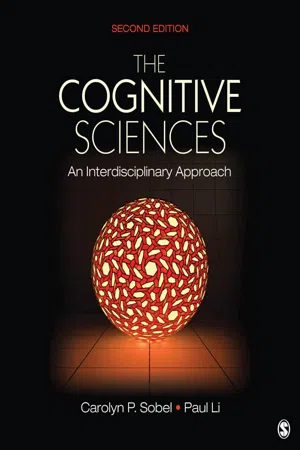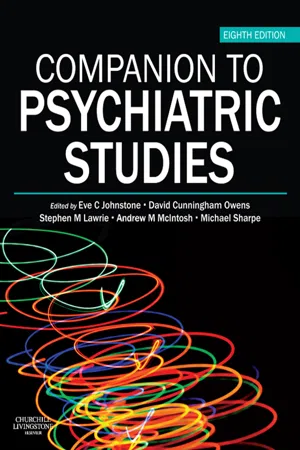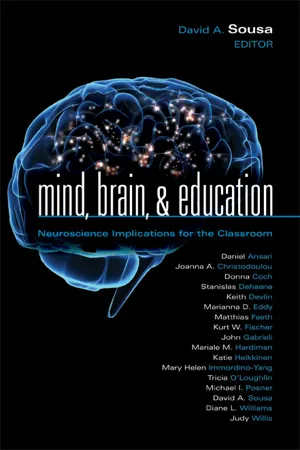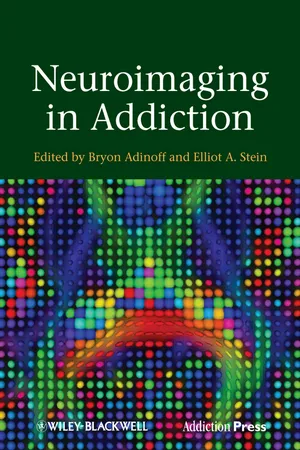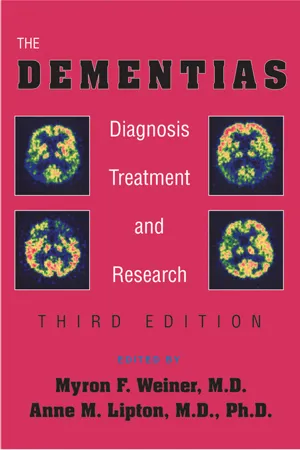Psychology
Neuroimaging Techniques
Neuroimaging techniques are methods used to visualize the structure and function of the brain. These techniques include magnetic resonance imaging (MRI), functional MRI (fMRI), positron emission tomography (PET), and electroencephalography (EEG). They provide valuable insights into brain activity and are widely used in research to understand various psychological processes and disorders.
Written by Perlego with AI-assistance
Related key terms
12 Key excerpts on "Neuroimaging Techniques"
- eBook - ePub
- David B. Arciniegas, Stuart C. Yudofsky, Robert E. Hales(Authors)
- 2018(Publication Date)
- American Psychiatric Association Publishing(Publisher)
CHAPTER 4 Neuroimaging in Neuropsychiatry Robin A. Hurley, M.D., FANPA Shiv S. Patel, M.D. Katherine Taber, Ph.D., FANPA The marvels of engineering and physics have provided powerful approaches to elucidating the brain-based sources of emotion and behavior. Subspecialists in behavioral neurology and neuropsychiatry assess and treat patients with cognitive, emotional, and/or behavioral disturbances due to brain dysfunction. The advent of multiple methods to image the brain has contributed significantly to the knowledge base of this subspecialty. During the past century, neuroimaging technology advanced from providing a primitive skull X-ray to furnishing highly detailed pictures of brain structure and function. Cutting-edge neuroimaging can contribute not only to the diagnosis but also to prognosis, prediction of treatment response, and development of new treatments (Filippi et al. 2012 ; Osuch and Williamson 2006). Clinical Neuroimaging There are two categories of neuroimaging currently used in clinical neuropsychiatry (Aguirre 2014 ; Carter and Coles 2012 ; Malhi and Lagopoulos 2008): structural neuroimaging and functional neuroimaging. Structural neuroimaging technologies are used to evaluate brain tissue integrity and to identify abnormalities associated with many pathological processes; computed tomography (CT) and magnetic resonance imaging (MRI) are the most commonly used structural neuroimaging technologies in clinical neuropsychiatry. Functional neuroimaging provides images that (indirectly) reflect brain activity, the most common of which do so by measuring blood flow, glucose, and oxygen utilization; single-photon emission computed tomography (SPECT) and positron emission tomography (PET) are the most commonly used functional neuroimaging technologies in clinical neuropsychiatry - eBook - ePub
Introducing Neuropsychology
2nd Edition
- John Stirling, Rebecca Elliott(Authors)
- 2010(Publication Date)
- Psychology Press(Publisher)
CHAPTER 2 Methods in neuropsychologyCONTENTS
Introduction 21Invasive techniques for measuring brain structure and function 22Electrical procedures 25In-vivo imaging 27Neuropsychological assessment 32Chapter summary 37INTRODUCTION
In this chapter we introduce some of the methods that are used in neuropsychology to explore the relationship between brain structure and function. In Chapter 1 we described neuropsychology as a “bridging discipline” and consequently there are a wide range of methodologies involved—from neuroanatomical procedures at one end of the spectrum, through to experimental psychology assessments at the other. The advent of in-vivo Neuroimaging Techniques over the last 20 years has revolutionised neuropsychology, providing research opportunities that were previously unthinkable. In-vivo imaging has, for example, confirmed some of the long-suspected roles of particular brain regions in certain psychological processes (e.g., the role of anterior cingulate cortex in attention; see Chapter 9 ). Imaging techniques have also revealed the complexity inherent in functions that traditional neuropsychology had previously oversimplified. Imaging of language processes is an example of this, as discussed in Chapter 6 .While imaging techniques have undoubtedly provided a wealth of new information, it is important to be aware that they are not without limitations. Older techniques have therefore remained valuable, in spite of predictions of their demise. In fact imaging and traditional neuropsychology techniques provide complementary methodologies, generating more information when used in conjunction than either could do alone. A key element of imaging studies in neuropsychology is the vital importance of good experimental design aimed at testing specific hypotheses. In the excitement of newly available techniques, it is important to remember that they are simply techniques to answer interesting questions— neuroimaging is a means not an end. - eBook - ePub
Brain Research in Education and the Social Sciences
Implications for Practice, Parenting, and Future Society
- Doris Bergen, Joseph Schroer, Michael Woodin(Authors)
- 2017(Publication Date)
- Routledge(Publisher)
Professionals in neuropsychological fields provide interpretation of neurodiagnostic techniques and recommend diagnostic instruments that enable them to diagnose brain difficulties. Guidelines for such tests are described in Chapter 12. As noted by Tonkonogy and Puente (2009), “Historically, neuropsychological studies existed without reference to brain-imaging studies and vice versa. Over the last decade the two have interfaced, resulting in exciting discoveries and a greater understanding of brain dysfunction” (p. 20). Application of Neuroimaging and Neurodiagnostic Research Neuroimaging Techniques are used extensively to help researchers and practitioners learn more about typical and atypical brain functioning, and these methods are gaining increasing importance. As Poldrack (2006) has noted, however, the techniques are not yet appropriate for accurately identifying certain areas of the brain responsible for specific cognitive processes—both because such processes are complex and may involve many areas of the brain, and because the techniques are still relatively imprecise. Although these techniques hold promise for diagnosing and predicting how brain areas may be affected by disease or injury, at present the application of research to practice is still in early stages. Results are useful in conjunction with neuropsychological evaluations to give diagnosticians additional insight into the prognosis and treatment of many diseases that affect brain functioning. Research studies investigate both which areas of the brain are activated when certain types of experiences are presented, and developmental differences in brain structures and functions at various age levels. Also, studies are investigating brain activation differences in individuals with learning problems, diseases involving brain functioning, and other conditions. Some findings have been discussed in earlier chapters - eBook - ePub
- Anita Thapar, Daniel S. Pine, James F. Leckman, Stephen Scott, Margaret J. Snowling, Eric A. Taylor, Anita Thapar, Daniel Pine, James F. Leckman, Stephen Scott, Margaret J. Snowling, Eric A. Taylor(Authors)
- 2015(Publication Date)
- Wiley-Blackwell(Publisher)
Chapter 11 Neuroimaging in child psychiatryKevin Pelphrey, Brent Vander Wyk and Michael CrowleyChild Study Center, Yale University, New Haven, CT, USAIntroduction
Neuroimaging offers an opportunity to better understand psychiatric disorders via investigations of brain structure, function and/or molecular composition, and developmental change. In this chapter, we provide an overview of modern techniques that are currently used for studying the living and developing brain. We illustrate these neuroimaging methods with accessible examples of how the techniques have been used to advance our understanding of childhood psychiatric disorders. More details about specific findings can be found in the chapters devoted to specific disorders; here, we focus on the examples only long enough to bring the different neuroimaging methods to life. Finally, the chapter on systems neuroscience broadly outlines the way in which neuroimaging interfaces with neuroscience to delineate the neural correlates of developmental psychopathology. This provides a conceptual grounding for research on brain–behavior relationships, as can be quantified through imaging.In its infancy, the study of brain function relied upon recordings of individual neurons grown in petri dishes, invasive electrodes placed in nonhuman animals, and neuropsychological studies of patients with circumscribed lesions. Several neuroimaging approaches, specifically functional magnetic resonance imaging (fMRI), electroencephalography (EEG), and functional near infrared spectroscopy (fNIRS), have emerged over the past 20 years as noninvasive methods by which we can reliably examine the function and structure of the developing human brain across the lifespan. The field can now utilize a “molecules-to-mind” approach, studying key phenomena across multiple levels of analysis including genes, brain, behavior, and the broader environmental context. These Neuroimaging Techniques are now routinely used to study healthy function, and dysfunction, of the brain during its maturation across development. An increasing proportion of the literature is dedicated to describing results from one neuroimaging method or another, and much of the remaining work is now interpreted in the context of what is known, or thought to be known, about brain function. More and more, those working in the proverbial “trenches” in the field of child and adolescent mental health are expected to be informed and critical consumers of this research. - eBook - ePub
- Matt Carter, Jennifer C. Shieh(Authors)
- 2015(Publication Date)
- Academic Press(Publisher)
Table 1.1 compares the spatial and temporal resolutions, cost, and invasiveness of the various functional brain imaging techniques described previously. As mentioned before, many imaging laboratories now combine multiple techniques to make up for the inadequacies of any single technique. For example, fMRI offers excellent spatial resolution and is noninvasive, but it does not offer good temporal resolution of neural activity during experiments because the BOLD effect occurs over a period of 6–10 s. Therefore, some laboratories combine fMRI with MEG or EEG, in which signals can be detected within a fraction of a second.Figure 1.17 Optical imaging.Light is shined onto the surface of the brain. A portion of this light is reflected off the brain and detected by multiple optrodes. Changes in neural activity produce changes in the amount of light that is absorbed and reflected by the brain. Therefore, optical imaging can be used to indirectly detect changes in neural activity. These techniques can be either invasive (the skull is opened to reveal the surface of the brain) or noninvasive.Table 1.1 Comparison of Functional Imaging TechniquesSpatial resolution Temporal resolution Cost Invasiveness fMRI 1 mm 6–10 s Expensive Noninvasive PET 4 mm 1 min Very expensive Radioactive injection SPECT 8 mm 2–8 s Expensive Radioactive injection EEG 1 cm 1 ms Moderate Noninvasive MEG 1 mm 1 ms Very expensive Noninvasive Optical imaging 1 mm 2–8 s Inexpensive Can be invasive So far, this chapter has focused almost exclusively on the technology of structural and functional brain imaging. Of course, the utility of these technologies depends entirely on how they are used: the research hypotheses, experimental designs, and methods of data analysis. In the last part of this chapter, we will examine the approaches that can be taken in the design and analysis of functional imaging experiments.Functional Imaging Experimental Design and Analysis
Functional imaging technologies are particularly well suited to cognitive neuroscience - eBook - ePub
- Allan Tasman, Jerald Kay, Jeffrey A. Lieberman, Michael B. First, Mario Maj, Allan Tasman, Jerald Kay, Jeffrey A. Lieberman, Michael B. First, Mario Maj(Authors)
- 2011(Publication Date)
- Wiley(Publisher)
CHAPTER 33 Brain Imaging in PsychiatryDouglas S. Lehrer1Darin D. Dougherty2Scott L. Rauch31 Department of Psychiatry, Wright State University Boonshoft School of Medicine, Dayton, OH, USA2 Department of Psychiatry, Massachusetts General Hospital, Boston, MA, USA3 McLean Hospital, Belmont, MA, USAIntroductionThe development of noninvasive techniques for assessing brain structure, function, and chemistry has progressed rapidly, since the innovation of computed tomography in the early 1970s through the current generation of imaging methods. We now use a number of neuroimaging modalities in the conduct of psychiatric research, and can state with little fear of contradiction that no other method of neuroscientific investigation has done more to advance our knowledge of the pathophysiology of mental disorders than has in vivo neuroimaging. Moreover, it is now clear that without a practical understanding of commonly employed imaging methods, the psychiatrist cannot stay abreast of our professional literature. This chapter will review common methods of neuroimaging, equipping the clinician with the practical knowledge of imaging techniques needed to digest related scientific articles. We will not review specific imaging-based research findings, leaving that to those chapters addressing the pathophysiology of specific psychiatric disorders.Beyond the use of imaging in research, we have recently seen the expansion of neuroimaging into clinical psychiatry beyond the traditional role of aiding in the differential diagnosis of neuropsychiatric conditions to rule out a general medical cause (e.g., brain tumor) for altered mental status (“rule out organic”). We will discuss these emerging clinical applications, along with speculations about the future of imaging in clinical psychiatry.Contemporary neuroimaging modalities can be roughly divided into either structural modalities or functional modalities. Structural modalities are designed to produce anatomic images of the body, and include computed tomography (CT) and magnetic resonance imaging (MRI). Functional modalities produce images that reflect some aspect of physiologic function, and include positron emission tomography (PET), single photon emission computed tomography (SPECT), functional magnetic resonance imaging (fMRI), and magnetic resonance spectroscopy (MRS). We may subdivide function imaging into methods that measure regional metabolism or blood flow, versus those that probe specific neurochemical pathways, that is, molecular imaging - eBook - ePub
Psychophysiology
Human Behavior and Physiological Response
- John L. Andreassi(Author)
- 2010(Publication Date)
- Psychology Press(Publisher)
FIG. 9.1. An MRI of the brain showing white matter, gray matter, and a portion of the third ventricle (black butterfly shape) at the center. The two circles indicate the left and right amygdalae From Abercrombie et al. (1998). Copyright 1998 by Lippincott, Williams, and Wilkins. Adapted by permission.techniques that involve optical imaging. The magnetoencephalogram, involving measures of the brain’s magnetic fields, is also discussed. Several approaches that utilize optical imaging for studying the brain have been described by Gratton, Fabiani, Elbert, and Rockstroh (2003). An optical imaging technique that has psychophysiological applications is a process called photon migration . Another relatively new neuroimaging technique is referred to as SPECT (single photon emission computed tomography) . Both SPECT and PET use radioactive tracers that are injected into the bloodstream. The bloodstream carries the tracer to the brain where local concentration is higher in areas with an increased blood flow or metabolism. The Neuroimaging Techniques mentioned here have enabled psychophysiologists and other neuroscientists to determine which brain areas become active during sensation, attention, perception, memory, language, emotion, and language processing. They have also enabled the examination of brain areas affected by stroke and various neurological diseases.POSITRON EMISSION TOMOGRAPHY (PET)
The PET imaging technique has allowed clinicians and scientists to study normal and abnormal brain function. The so-called PET scan permits the viewing of various brain regions through a technique that combines computed tomography and a tracer assay method (Aine, 1995). The PET technique can provide information about glucose and oxygen metabolism in brain structures, blood flow in brain tissue (cerebral blood flow), and blood volume in brain areas (cerebral blood volume). The method allows researchers to view cross sections of different brain areas that are color coded to indicate differing amounts of activity. For example, red indicates high levels of brain metabolic activity whereas yellow, green, and blue areas depict progressively lower metabolic levels of a particular brain region during the task being performed. An example of a PET scan of the brain is provided in Fig. 9.2 - eBook - ePub
The Cognitive Sciences
An Interdisciplinary Approach
- Carolyn P. Sobel, Paul Li(Authors)
- 2013(Publication Date)
- SAGE Publications, Inc(Publisher)
Functional mapping reveals where reactions are taking place in the brain as parts of the body move or external events such as a light in the visual field affect it (Cheney, 1996). Although this type of mapping does not provide the high resolution provided by techniques that record the activity of specific neurons, ideally it has the advantage of providing a complete picture of the brain, and it allows the identification of regions involved in particular functions, such as reading or solving a problem. Functional brain mapping is a major direction being taken by contemporary neuroscientific research. In this section, we examine briefly the major tools currently used to advance this research.Electrophysiological Techniques
Among the functional brain mapping techniques are several that employ electrophysiological methods. We look at each of these in turn.ELECTROENCEPHALOGRAPHY
In 1929, an important paper was published in Jena, Germany, by the neurologist and psychologist Hans Berger (1873-1941). It was the first of a series describing a new technique for imaging the activity in the brain. The technique, called electroencephalography, involves first attaching electrodes to the scalp with a paste or liquid that enhances the conducting of electricity. Then the changes in voltage from each electrode are amplified and recorded as line tracings on paper. These tracings, called electroencephalograms, or EEGs, are recordings of patterns of electrical activity in the brain. They give a fine-tuned reading of rapidly occurring changes, which MRI cannot do because it is too slow.Berger’s series of papers described “nearly all the main EEG findings of cerebral diseases and the EEG alterations of normal subjects during attention, sleep, and narcosis - eBook - ePub
- Eve Johnstone, David G. Cunningham-Owens, Stephen Lawrie, Andrew McIntosh, Michael D. Sharpe(Authors)
- 2010(Publication Date)
- Churchill Livingstone(Publisher)
4 NeuroimagingJ Douglas Steele, Stephen M. LawrieIntroduction
Psychiatric disorders are associated with disturbances of brain structure and function. This fact, although not remarkable in itself, has taken the best part of 30 years of work to gain widespread acceptance. We have an ever increasing array of sophisticated and complementary neuroimaging methods with which we can study the brain/mind in vivo, and the now substantial imaging literature on many psychiatric disorders has generated several replicated findings. Refinements of techniques and their application to particular populations will likely provide further insights into the pathophysiology of these disorders in the coming years. Some procedures are now finding routine clinical application in certain conditions and are increasingly used to facilitate the development of new treatments. In this chapter we will briefly describe the principal neuroimaging methods currently used, summarise the best replicated and most promising findings in particular disorders, consider the most likely clinical applications and finally address important general issues. Only an introduction to these matters can be provided here. For more detail the reader is referred to other texts (Moonen & Bandettini 2000 ; Frackowiak et al 2004 ; Lawrie et al 2004 ).Structural brain imaging techniques
The first attempts at imaging brain structure in vivo were conducted using pneumoencephalography. After lumbar puncture, cerebrospinal fluid (CSF) was withdrawn and replaced with a gas, usually air, to outline the cerebral ventricles and cortical surface using X-ray roentgenography. The technique was first applied to psychiatric patients by Jacobi & Winkler in 1927, who described an apparent loss of brain tissue in schizophrenia. Enlarged lateral and third ventricles, as well as widened cortical sulci, with progression in chronic cases, proved to be widely replicated findings (Lawrie et al 2004 - eBook - ePub
Leading Edge
Neuroscience Implications for the Classroom
- David A. Sousa, David A. Sousa(Authors)
- 2010(Publication Date)
- Solution Tree Press(Publisher)
Chapter 2
__________________________Neuroimaging Tools and the Evolution of Educational Neuroscience
Michael I. Posner
The key element in the evolution of educational neuroscience was the development of cognitive neuroimaging in the late 1980s. In this chapter, I review the historical record of developments in brain imaging methods such as measurement of changes in blood flow and of electrical and magnetic activity (in both healthy patients and in patients with brain damage). Together, these methods have illuminated the acquisition of literacy, numeracy, expertise, and other aspects of education.Hemodynamic Imaging
Efforts to image the human brain are ancient, but the modern era began with computerized tomography, or CT scans, which use mathematical algorithms to combine X-rays in such a way as to produce a picture of the brain’s structure. However, the images most needed were those showing the brain’s function during performance of everyday tasks. Efforts to map the function of the brain began by measuring blood flow. Using radionucleides that emit photons when in contact with matter, researchers counted the frequency of emissions to map changes in blood flow at various locations in the brain. The major methods used to develop these maps were single photon emission computed tomography (SPECT) and positron emission tomography (PET) (for an extensive history of this field, see Savoy, 2001).The images most needed were those showing the brain’s function during performance of everyday tasks.Using PET Imaging
In the late 1980s, it became possible to examine changes in the intact brain while people carried out tasks involving thinking. One method used was called positron emission tomography. PET took advantage of the fact that when brain cells are active, they change their own local blood supply. Using PET, it is possible to show which portions of the brain are active. The PET mapping method was first employed to show how, during tasks such as reading or listening to music, much of the brain, but not the whole brain, exhibited increased blood flow (Lassen, Ingvar, & Skinhoj, 1978). In an important early study, researchers compared specific tasks such as navigating from place to place while reading and listening; the results showed clear regional distribution of brain activity—activity that differed depending on the task (Roland & Friberg, 1985). Prior to the development of functional brain imaging, cognitive psychologists had already broken down tasks such as reading, attention, and visual imagery into component operations or subroutines sufficient to program a computer to perform the tasks (Kosslyn, 1980; Posner & Raichle, 1994). Relating these subroutines to specific brain areas was an important step toward making brain maps useful in psychology and education. - eBook - ePub
- Bryon Adinoff, Elliot A. Stein, Bryon Adinoff, Elliot A. Stein(Authors)
- 2011(Publication Date)
- Wiley(Publisher)
Chapter 3 Structural and Functional Neuroimaging Methods: Applications to Substance Abuse and Addiction Yihong Yang, Svetlana Chefer, Xiujuan Geng, Hong Gu, Xi Chen, and Elliot A. Stein Neuroimaging Research Branch, National Institute on Drug Abuse-Intramural Research Program, Baltimore, MD, USA 3.1 Introduction Although stretching back to the mid 1950s for Positron Emission Tomography (PET) scanning, and the early 1970s for magnetic resonance imaging (MRI), both modalities quickly became commercialized and entered the research and clinical arenas in the mid 1980s. Among the precipitating factors, it was the advent of flurodeoxyglucose (18 F) to measure brain metabolism and [O 15 ]H 2 0 to measure cerebral blood flow, followed by the development of specific radioligands, which propelled the nascent field of functional imaging. The development of functional MRI in the early 1990s rapidly followed. In the relatively short period thereafter, non-invasive imaging technology has exploded onto the human neuroscience research arena. Initial efforts in the field were mostly limited to understanding the tool and the signal they provided. Probing the healthy brain quickly emerged and rapidly helped create and then dominated new research fields like cognitive neuroscience. While research pioneers began applying these tools to pathological populations quite early, it has only been little more than a decade where imaging has been almost routinely used to understand the underlying pathophysiology of neuropsychiatric disorders. What has greatly aided this nascent inquiry is the impressive and continued development of novel radiotracers, in the case of PET imaging, and exciting new pulse sequences and hardware to acquire higher quality and diverse signals from MRI - eBook - ePub
The Dementias
Diagnosis, Treatment, and Research
- Myron F. Weiner, Anne M. Lipton(Authors)
- 2008(Publication Date)
- American Psychiatric Association Publishing(Publisher)
Promising methodological developments in the analysis of structural MRI data include the use of probabilistic brain maps to compute regional alterations in gray matter, white matter, CSF, and whole brain. This developing technique, known as voxel-based morphometry, uses fully automated linear and nonlinear warping computer algorithms to place brain scans into a common template space with stereotactic coordinates; to segment the image into gray matter, white matter, and CSF; and to compute differences in tissue concentration or degree of deformation to test group differences that can reflect alterations in shape and size of specific brain structures, whole brain, or cortical atrophy (Fox et al. 2001; Good et al. 2001; Thompson et al. 2001). Although these methods are only beginning to be applied in Alzheimer’s disease and other neurodegenerative diseases, they hold great promise for enhancing the ability to detect the earliest effects of these diseases, to track their progression, and to evaluate treatments to diminish or delay the progression of neurodegenerative diseases (Reiman et al. 2001a).Functional Neuroimaging
Interest in the use of functional brain imaging in the evaluation of dementing illness has grown in recent years with the increasing availability of these imaging techniques and growing research suggesting that functional imaging methods may have a helpful role in aiding diagnosis. These methods may be especially helpful when patients present with unusual or confusing clinical symptoms. Functional Neuroimaging Techniques can potentially provide supportive evidence for several forms of dementia, including Alzheimer’s disease, vascular dementia, frontotemporal dementia, and asymmetrical or focal cortical degeneration syndromes. Research in the clinical application of these functional neuroimaging methods has ranged from using simple rating scales with visual inspection to applying complex computerized algorithms that provide probabilistic brain maps of cerebral activity to test the ability of these neuroimaging methods in aiding early diagnosis, in tracking progression in Alzheimer’s disease, and evaluating individuals at risk for developing Alzheimer’s disease. In this section, we review the two most commonly used functional imaging methods in the evaluation of cognitive dysfunction, PET and SPECT. We also discuss the potential for developing clinical applications from two neuroimaging research methods that assess physiological and chemical processes in the brain, fMRI and MRS.Positron Emission Tomography
PET is a functional imaging technique that can provide information on physiological and chemical processes that occur in brain tissue and that may be useful in the evaluation of dementia. In PET, positron-emitting radiotracers are used to construct images of functional brain activity. These unstable radiotracer compounds have an excess of protons in their nuclei. Positrons with the same mass as an electron but with a positive charge are emitted and have the kinetic energy to travel a few millimeters within tissue. When it is nearly at rest, the positron interacts with an unbound electron, causing an annihilation event to occur. This results in two gamma ray photons of 511 KeV energy being emitted at 180 degrees from each other (Horwitz 1990). In a PET scanner, the gamma photons are detected by rings of detectors surrounding the head. Pairs of these detectors face each other and are connected by an electronic coincidence circuit that detects the photons emitted at the moment when the positron meets an electron. The multiple pairs of coincidence circuits in the scanner measure the number of photon pairs originating from all angles. Through a computer algorithm, it is possible to determine both the amount and the regional location of activity throughout the brain.
Index pages curate the most relevant extracts from our library of academic textbooks. They’ve been created using an in-house natural language model (NLM), each adding context and meaning to key research topics.
